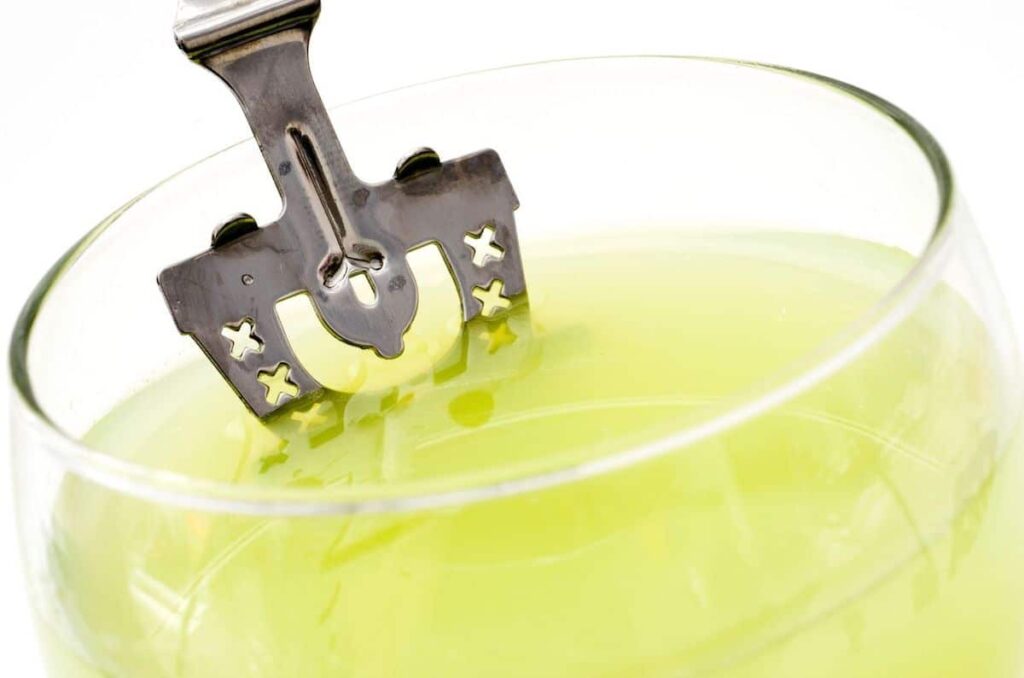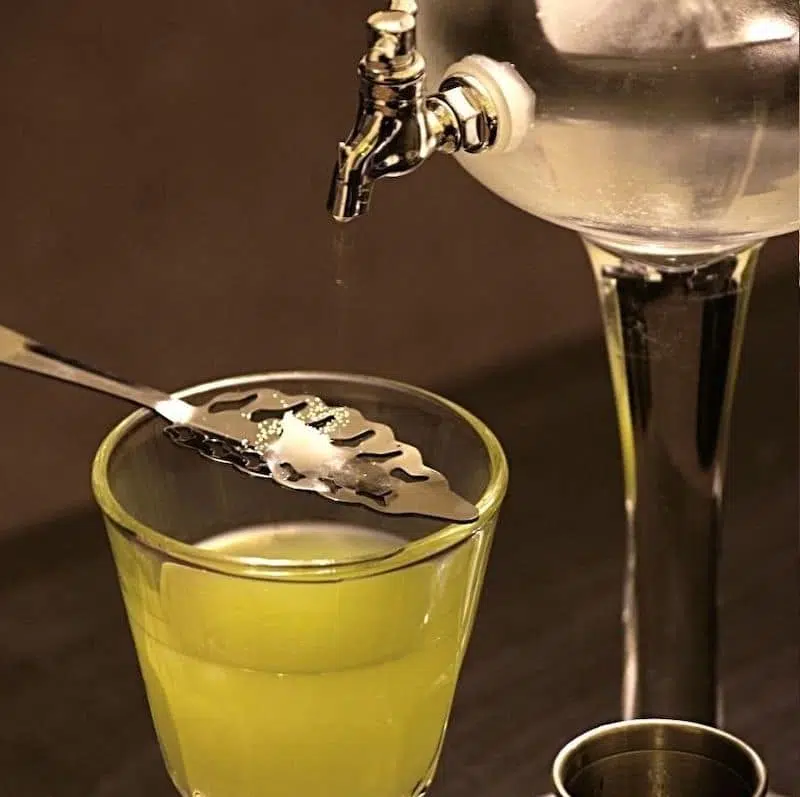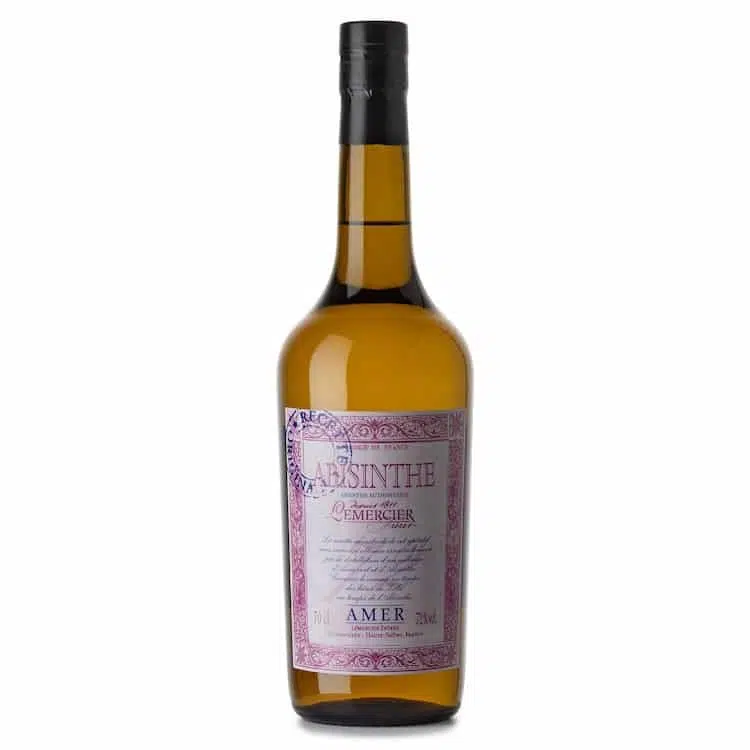Absinthe is a sweet, anise, and licorice-flavored over-proof spirit invented in Switzerland. On average, a bottle of the green-colored spirit contains between 53% and 75% of alcohol by volume. It can be made from a variety of ingredients yet the most common ones are green anise, Grande Wormwood, and Florence fennel.
Absinthe has a mysterious air surrounding it. Many countries banned it for decades, and it got blamed for van Gogh cutting off his ear. The latter is wrong, as van Gogh suffered from depression and cut off his ear after a confrontation with Paul Gauguin. No Absinthe involved.
What exactly is Absinthe?
Absinthe is an over-proof (more than 50% ABV), green-colored spirit made from various herbs. Depending on the brand, you will find an extensive range of ingredients. The most common are green anise, Grande Wormwood, and Florence Fennel.
The roots of Absinthe are in Switzerland. That is why most of the herbs used for making it are from either Switzerland or France. It traditionally has an intense anise, almost licorice-like, taste. This green liquor was invented in the late 1700s by Pierre Ordinaire and quickly won the love of enthusiastic drinkers in France in the early 19th century.
Is Absinthe legal?
Yes, today, Absinthe is legal in most countries. However, that was not always the case. Shortly after the beginning of World War I, many countries began to ban the the spirit, only to lift it again in 1988 (Europe), respectively 2007 (Unites States). But let's take a closer look at the historical timeline.
History
The very roots of the spirit are in ancient Egypt. Back then, people used it for medical purposes. But, as mentioned before, the spirit, as we know it today, was invented in the late 1700s in Switzerland. It quickly got famous in France, reaching its peak in popularity in the 1800s.
During the Belle Époque from 1871 to 1880, it was the favorite drink of many prominent figures. For instance, world-renowned artists like Vincent van Gogh, Oscar Wilde, and Ernest Hemingway, to name a few.
During this time, Absinthe was available and served almost everywhere. From cozy little Cafés to Bistros and Cabarets.
Then, in the early 1900s, it suddenly got banned in almost every country. The governments did that because of Thujone. Back then, people thought it would cause hallucinations and other unwanted side effects.
It all started in the US in 1912. France followed suit shortly after world war I began, and most other countries did the same. Spain and the Czech Republic continued production and consumption. That might be the main reason why, today, the Czech are leaders in Absinthe consumption.
The ban in Europe was lifted with the European Union's standards of 1988. In 2007, the United States legalized the high-proof spirit almost 20 years after the EU.
How to drink Absinthe
Absinthe can be used in cocktails, where its strong and distinct taste adds complexity to any drink. But traditionally, it is consumed either in combination with sugar and water (louche) in the Swiss preparation or by mixing it with burned sugar. The latter only works with Czech-style Absinthe.
Depending on the type you've got in front of you, there are different rituals to drink it properly.

How to prepare Absinthe
There are two traditional ways of preparing Absinthe - the Swiss and the Czech. So let's take at those two rituals:
The Swiss way of drinking it
The traditional ritual for Swiss-style products includes a serving of 1 to 2 ounces of Absinthe in a glass, an Absinthe spoon with a sugar cube on top, and a water fountain.
The water slowly drops on the sugar cube until it's completely dissolved. The water to Absinthe ratio is then around 3:1. The drink will also turn milky and cloudy during the process due to the anise in the spirit. This effect is also called louche and is best known in Ouzo.
So, here's the traditional Absinthe ritual:
- Fill a glass with 1 to 2 ounces of Absinthe, depending on your preference.
- Cover the glass with an Absinthe spoon and put a sugar cube on top.
- Slowly drip ice-cold water over the sugar cube. As the water drips into the spirit, the drink becomes cloudy. -This is the louche effect. Aim for 3 parts water per 1 part of the green fairy.
- Use the spoon to mix everything well.
- Enjoy your drink by taking small sips. Drink a small mouthful of water after each sip.

The Czech ritual of drinking Absinthe
This is the second and more modern version to enjoy Absinthe. But it is only used for the macerated Bohemian version.
You dip a sugar cube into the spirit and place it on top of an Absinthe Spoon. Then you put the spoon on your glass filled with the spirit.
When igniting the soaked sugar cube, it begins caramelizing and slowly dripping into your glass. After 3 to 5 drops, dip the spoon into your glass and give the mix a good stir.
With this ritual, you get a warm drink with a very different flavor profile than the classic preparation.

Learn more
If you want to know more about the rituals, read how to drink Absinthe properly. And always keep in mind that even if not toxic, it still contains a high alcohol level. Drink slowly, sip by sip, and always drink water in between.
How Absinthe tastes
The taste of Absinthe is strongly herbal with lots of sweetness. People often describe these sweet notes as licorice which is not part of it. However, the combination of anise and fennel is tastewise quite close to licorice, hence the mixup.
Ultimately, the taste of Absinthe depends on the brand you're drinking. But mostly, you will come across this licorice-like taste paired with a variety of herbal flavors.
Types of Absinthe
Today, there are two types of Absinthe: the distilled and Bohemian version. Traditionally there was only the distilled version, but the Czech came up with their own style, which is prepared differently.
So let's take a closer look and see how exactly the two types of Absinthe differ.
Distilled Absinthe

The classic type of Absinthe is distilled. The herbal ingredients get macerated before or during the distillation process.
Then, after distillation, the final product is ready to be bottled. Distilled Absinthes have herbal notes dominated by anise.
Right after distillation, the spirit is as clear as other spirits like Gin or Vodka. This clear version is also known as Swiss-style, Blanche, or Bleue.
To achieve the typical green color, distillers infuse their product with herbs in the second step of production before re-distilling it. The result is called French-style or Verte and, traditionally, cannot be colored artificially.
Quality Swiss or French-style Absinthe is also known for turning cloudy when mixed with water. This effect is called louche and is caused by the essential oils in anise that are not soluble in water.
Switzerland is, by the way, the only country that has defined legal requirements for Absinthe. And the general absence of laws led to a second, macerated version.
Macerated Absinthe

The new type of macerated Absinthes originated in the Czech Republic. For this, grande Wormwood is infused with alcohol to release aroma and the typical green color.
The green color is usually coming naturally through the wormwood infusion in alcohol. Artificial coloring is allowed.
While the end product is still full of herbal notes, it has a less dominant anise taste. If you're not a fan of anise, that's a big plus.
Also, the Bohemian-style Absinthe has no louche effect due to the lack of essential oils from anise.
These two characteristics, or rather their absence, are why bartenders often prefer using Czech Absinthe in mixed drinks.
Thujone in Absinthe
Thujone is the main reason why Absinthe has a bad reputation. People accused the chemical compound of making consumers go mad and hallucinate. However, Thujone is neither a hallucinogen nor a psychedelic.
It is a chemical compound occurring naturally in Artemisia absinthium, better known as Grande Wormwood.
To be fair, Thujone is indeed toxic. But if you try to get intoxicated by it, you die of alcohol poisoning way before. Even sage contains more Thujone than Wormwood.
Ironically, despite all that, Absinthe legalization still depends on Thujone levels. In the US, only products with less than 10mg/L is legal. In the EU, you can purchase it with a Thujone level of up to 35mg/L.
By the way, the main reason for drinkers going bonkers was
- One, the high level of alcohol and Absinthe
- And two, the green spirit was so popular that swindlers created cheap imitations of inferior quality that led to unwanted side effects.
The Meaning of Chasing the Green Fairy
Simply put, when someone was chasing the green fairy, they aimed for artistic enlightenment and inspiration. The term Green Fairy is a well-known synonym for the green spirit. There even is a brand of Absinthe going by the name "Green Fairy."
Initially, it was just the translation of the French nickname "La Fée Verte", but it quickly became more than that. In the late 1800s, the fairy was a common symbol in France for transformation and innovation. And a green fairy drink was said to create a free mind where new and unorthodox ideas could arise.
A state every artist strives for to get new inspiration. Of course, this does not necessarily have to include alcohol. But back in the day, it often did.
Best Place to Learn More About Absinthe
One of the best places to learn about Absinthe is the Absintherie in Prague. This place knows exactly what it's doing. They have one of the largest Absinthe selections in the world and serve both Czech and Swiss style from hundreds of brands.
I've been there multiple times. It's fun to sit in front of those massive water fountains waiting for your drink to be ready. You can try macerated as well as distilled ones while talking to the bartenders about their differences.
They will happily answer any questions you may have. And in case you're looking for more places to visit once you're in Prague, here's a list of the best cocktail bars in Prague.
Top bottles to try
Here's a list of the best Absinthe brands you should try. Our overview includes the style, origin, ABV, Thujone levels, and price.
| Absinthe | Style | ABV | Thujone | Price |
|---|---|---|---|---|
| Kübler Absinthe | Distilled | 53% | 5mg/l | $50 |
| Pernod absinthe | Distilled | 68% | 10mg/l | $60 |
| La Clandestine Absinthe Supérieure | Distilled | 53% | 10mg/l | $70 |
| Beetle Absinthe | Macerated | 70% | 35mg/l | $120 |
Absinthe Cocktails
Sure, Absinthe is not the most common cocktail ingredient but it still is part of some classic cocktails like the Sazerac, Corpse Reviver No. 2, and Monkey Gland.
The boozy Sazerac cocktail was first created in New Orleans and required an Absinthe rinse during its preparation. The Corpse Reviver No. 2 is a little lighter than the Sazerac. Even if the name suggests otherwise. It contains just a dash of the high-proof spirit, but that's enough to bring in the spirit's distinct flavors. If you prefer something more fruity, try making a Monkey Gland cocktail.
For more cocktails with the Green Fairy, including one creation of Ernest Hemingway himself, check out our list of the 10 best Absinthe Cocktails.


I visited the Absintherie a few weeks ago and it was amazing. Learned so much about Absinthe, thank you for the recommendation
Hey Francesca,
Glad you liked it, it's indeed an excellent place to learn about Absinthe and the different rituals.
Cheers